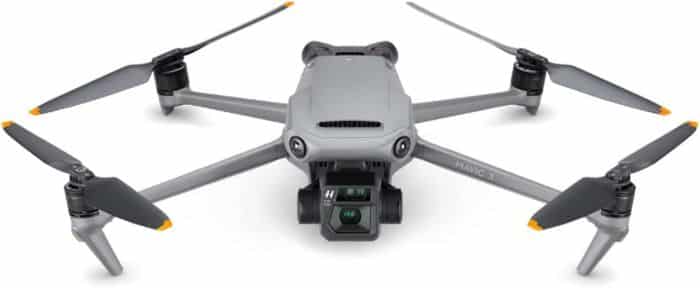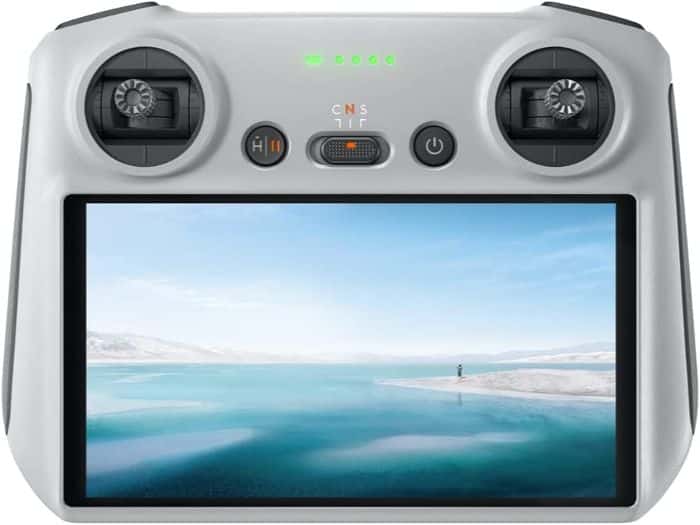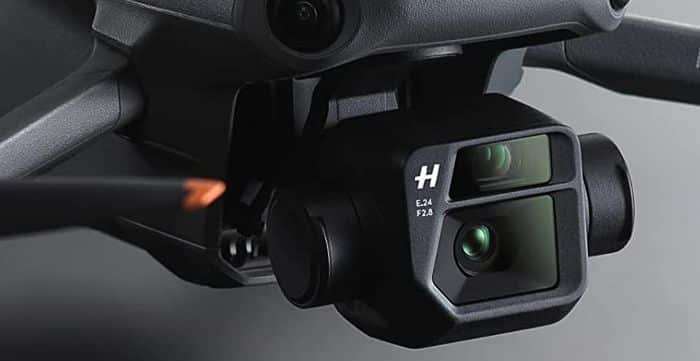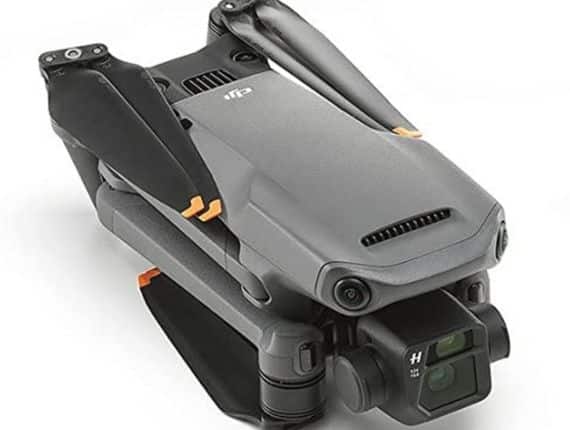The DJI Mavic 3 is a high-end drone designed for professionals who demand exceptional performance in aerial photography and videography. With advanced camera technology, an omnidirectional obstacle avoidance system, and intelligent flight features, it's an ideal choice for easily capturing stunning footage. While not suitable for beginners due to its advanced features and high price point, it's a worthwhile investment for professionals who need a reliable and robust drone for their work. The Mavic 3 is not waterproof and not recommended for flying in the rain, but it can handle wind speeds of up to 28 mph. Apart from professional photography/videography, the drone can also be used for mapping and 3D modelling; it's a versatile drone that can be used for various commercial applications.
Key Features
- Hasselblad-engineered main camera with a 4/3 CMOS sensor
- 20MP still photos and 5.1K video recording at 50fps
- Secondary camera with a large f/4.4 aperture and 28x hybrid zoom
- Obstacle avoidance system with binocular vision sensors and infrared sensor
- ActiveTrack 5.0 for intelligent subject tracking
- MasterShots for automated cinematic shots
- Max Flight Time of up to 46 minutes
- Max Flight Speed of up to 47 mph
- Max Transmission Distance of up to 15 km
The DJI Mavic range of drones are probably the most popular high-end consumer drones on the market. With the release of the DJI Mavic 3, DJI once again set the standard for high-quality camera drones. The DJI Mavic 3 is an incredibly versatile drone, boasting advanced features such as its dual camera system, 46-minute flight time, and an incredible transmission range of up to 15km. In this DJI Mavic 3 review, we’ll explore the design, camera, flight, and intelligent features and discuss who should consider purchasing the DJI Mavic 3.
DJI Mavic 3 Review – Design

Like previous Mavic drones, the Mavic 3 is foldable and ultra-portable. The arms fold neatly into the drone’s body, making it incredibly portable and easy to transport. When folded, the drone is only slightly larger than a water bottle, making it easy to slip into a backpack or carrying case.
Despite adding an extra camera and more sensors, the DJI Mavic 3 is lighter than the Mavic 2 Pro and Zoom. Despite its lightweight design, the drone feels durable and well-built. The drone is also very stable in flight, thanks to its powerful rotors, GPS module and vision sensors.
The drone comes with 8GB of internal memory, although DJI should consider expanding this in the future as it is not nearly enough for professional users. A micro SD card slot on the back will allow users to expand the memory up to 512GB. It should be noted that there is 1 TB of data storage in the Cine version of the Mavic 3, although in this version there is no room for memory expansion.
A LED light on the bottom of the drone will help users navigate if they do any night flying. As a side note, the FAA requires drone pilots must make sure that their drones have some kind of anti-collision beacon if they fly at night. Although the LED light can help pilots keep a visual line of sight, it is not an anti-collision beacon.
If you operate drones at night, you must attach a recommended anti-collision beacon that meets the standards set by the FAA. This requires the beacon to be continuously flashing and visible from 3 miles.
The drone also comes with a remote ID, another helpful feature, as remote ID will be mandatory on all drones after September 2023.
Remote Controller
The Mavic 3 is compatible with three controllers: the DJI RC-N1, DJI RC and DJI RC Pro. The RC-N1 is the standard controller; it’s the only one that does not have an integrated HD display screen. This will require you to attach a smartphone or a small tablet on the top and download the DJI Fly App to gain access to the drone’s advanced features and camera settings.
The DJI RC and RC Pro controllers have an integrated 5.5-inch display and HD resolution. The Pro controller is slightly brighter, with a 1000 cd/m² compared to the 700 cd/m² brightness for the DJI RC controller.
Both controllers come pre-installed with the DJI Fly App, and users can also download certain third-party apps for extra functionality.
As the DJI Mavic 3 uses the latest version of the OcuSync transmission technology, users will be able to receive live video feed in 1080p at 60fps from a maximum distance of 15km. However, this is subject to weather, obstacles and any radio interference. Also, unless users have permission from their local aviation authority, the drone must be kept in your line of sight.
The DJI RC and RC Pro controllers provide more functionality than RC-N1; however, this does come with a significantly higher cost.

My personal opinion is to purchase a package with the DJI RC controller, it costs less than the Pro controller but comes with many similar features including the 5.5-inch display. The HD screen is beneficial because it will not require you to attach your own mobile device.
DJI Mavic 3 Camera

The DJI Mavic 3 is equipped with an advanced camera system that is capable of capturing stunning images and videos. The primary camera on the Mavic 3 has been engineered by Hasselblad, a leading manufacturer of high-end cameras. The camera features a 4/3 CMOS sensor that captures 20MP images with incredible detail and clarity.
The adjustable aperture and high ISO range allow users to control the amount of light that enters the lens, making capturing high-quality images and videos in a range of lighting conditions more practical.
One of the most impressive features of the Mavic 3’s camera is its dynamic range. With 12.8 stops of dynamic range, the camera can capture a wide range of tones and colours, even in high-contrast scenes. This makes it easier to capture stunning images and videos with rich, vibrant colours and details.
Regarding video capabilities, the Mavic 3’s camera is equally impressive. It can record 5.1K videos at 50fps, DCI 4K at 60fps, and 4K at 120fps. The camera can also record videos in 10-bit DLog, allowing for greater post-processing flexibility. The camera supports video recording in Apple ProRes 422 HQ, 422 LT and H.265 and H.264.
In addition to the primary camera, the Mavic 3 has a secondary camera with a telelens. The camera has a large f/4.4 aperture and 28x hybrid zoom, which makes it ideal for capturing images and videos from a distance. The secondary camera can record videos in 4K and capture 12MP images, which makes it an excellent tool for photographers and videographers who need to capture detailed shots from a distance.
Overall, the camera system on the DJI Mavic 3 is one of its most impressive features. Its advanced sensor, adjustable aperture, and remarkable video capabilities make it an excellent choice for anyone who wants to capture stunning aerial images and videos.
Intelligent Features
The DJI Mavic 3 is has an advanced obstacle avoidance system that uses multiple sensors to detect obstacles in the drone’s flight path. The obstacle avoidance system consists of binocular vision sensors on the top, bottom, and sides and infrared sensors on the bottom.
The front binocular vision sensors on the Mavic 3 can detect obstacles up to 20 meters away, while the sensors on the bottom can detect obstacles up to 18 meters away. This gives the drone ample time to react and avoid obstacles, even in dense environments.
The Mavic 3’s obstacle avoidance system is one of the best for a consumer drone, and it is incredibly effective at helping users navigate challenging environments. The sensors work together to create a 360-degree view of the drone’s surroundings, which allows it to detect and avoid obstacles in any direction.
However, it is important to note that the obstacle avoidance system is only active in normal and cinematic modes and disabled in sports mode. This is because sports mode is designed for high-speed flight, and the obstacle avoidance system could interfere with the drone’s performance in this mode. It is important for users to be aware of this limitation and to fly the drone in the appropriate mode for their intended use.
Overall, the obstacle avoidance system on the DJI Mavic 3 is an impressive feature that sets it apart from many other consumer drones on the market. Its advanced sensors and comprehensive coverage make it an excellent choice for anyone navigating challenging environments while flying.
The Mavic 3 comes with ActiveTrack 5.0, the latest version of DJI’s subject-tracking technology.
ActiveTrack is a feature that allows drones to track and follow a subject while moving autonomously. This feature uses advanced computer vision algorithms and machine learning technology to identify and track the subject, ensuring that it stays in the centre of the frame as the drone moves.
To use ActiveTrack, users need to select the subject they want the drone to track using the DJI Fly App, and the drone will automatically follow the subject as it moves. The drone can track various subjects, including people, animals, and vehicles.
ActiveTrack is particularly useful for capturing footage of fast-moving subjects like athletes, wildlife, or vehicles. It allows users to keep the subject in the frame while the drone moves, creating dynamic and engaging footage that would be difficult to capture with manual flight controls.
This feature lets users track their subject matter from different angles or sides.
Although many high-end drones have this feature, the Mavic 3 excels because of its advanced image-tracking capability and obstacle-avoidance system.
Watch the video below to see ActiveTrack 5.0 and the obstacle avoidance system at work.
Point of Interest (POI) and Spotlight are the other two intelligent flight modes. POI allows the drone to lock on to subject matter and orbit that position autonomously, while with Spotlight, the camera will lock onto a subject matter while the pilot controls the drone.
The drone also has an advanced return to home (RTH) function that uses machine learning to find the most efficient route back to its home point. The RTH function is automatically activated whenever the battery gets low on charge, or the connection between the controller and drone is lost for more than six seconds.
Intelligent Video Recording Modes
The QuickShot feature on the DJI Mavic 3 is a set of pre-programmed flight modes allowing you to easily capture short cinematic videos.
With QuickShot, you can choose from six different flight modes that automatically fly your drone in a specific pattern while recording video.
Mastershots is another impressive video recording mode available on DJI Mavic 3. This mode works similarly to Quickshots, but it offers a unique touch by automatically executing various manoeuvres while keeping the subject in focus, resulting in a beautifully captured short video.
Mavic 3 vs Mavic 3 Classic, What’s The Difference?
The Mavic 3 Classic was released a few months after the original Mavic 3. The main difference between the two drones is the camera. The Mavic 3 Classic comes with the 4/3 camera but not the telelens camera. The Mavic 3 Classic cannot record in Apple ProRes 422 HQ/LT and does not have a gimbal lock. These differences make the Mavic Classic slightly cheaper than the original Mavic 3.
Who Should Buy This Drone?
The DJI Mavic 3 has been designed for professionals who require high-quality aerial footage rather than for casual users. Its advanced camera technology, long battery life, and comprehensive obstacle avoidance system make it an ideal tool for professional videographers and photographers needing a reliable and easy-to-use drone to capture stunning aerial footage. While it may be more expensive than many other consumer drones on the market, the Mavic 3’s advanced features and capabilities make it a worthwhile investment for anyone who wants to use this drone for commercial applications. If you are a professional needing a high-end drone that can deliver exceptional performance and features, the DJI Mavic 3 is an excellent choice that will meet your needs.
However, it is expensive, and if you are on a tight budget, plenty of good alternatives can produce similar results.
These include the Mini 3 Pro, Air 2S, and Autel Evo Lite Plus.
Final Thoughts
The DJI Mavic 3 is a high-end drone designed for professionals who demand exceptional aerial photography and videography performance. With advanced camera technology, a comprehensive obstacle avoidance system, and intelligent flight features, it’s an ideal choice for easily capturing stunning footage. While not suitable for casual users due to its price and advanced features, it’s a worthwhile investment for professionals who need a reliable and robust drone for their work. Overall, the DJI Mavic 3 is a top-of-the-line drone that impresses with its versatility, ease of use, and range of advanced features.
FAQ’s
Is the Mavic 3 worth it?
Yes, the Mavic 3 is worth the investment if you are a professional photographer/videographer and looking to expand your business services. However, for the casual drone pilot, the Mavic 3 is a little too expensive to fly just for fun.
Is the Mavic 3 a professional drone?
Yes, the Mavic 3 is designed for professionals, its a versatile drone that can be used for photography, videography, mapping, and 3D modelling as well as other commercial applications.
Can you fly the Mavic 3 in the rain?
No, flying the Mavic 3 in the rain is not recommended, as it’s not waterproof and can get damaged.
Is the Mavic 3 good for beginners?
Although the Mavic 3 is easy to operate, even for beginners, I would not recommend it because it has been developed for professionals and is expensive.
What wind speed can the Mavic 3 fly in?
The Mavic 3 can fly at wind speeds of up to 28 mph.
Can the Mavic 3 be used for Mapping?
Yes, the Mavic 3 can be used for Mapping; however, two versions of the Mavic 3 have been designed explicitly for Mapping and 3D modelling; they are the Mavic 3 Enterprise and Mavic 3 Multispectral.
Does the Mavic 3 have Remote ID?
Yes, the Mavic 3 does have remote ID that the FAA has approved.


